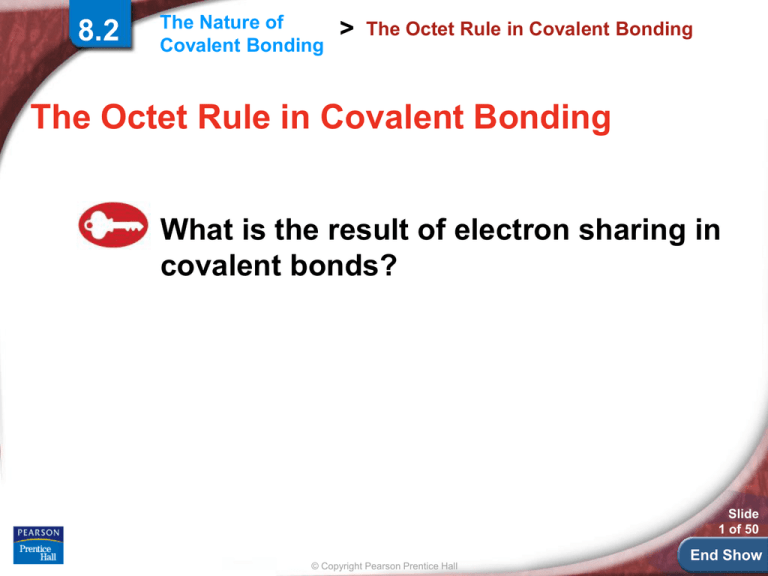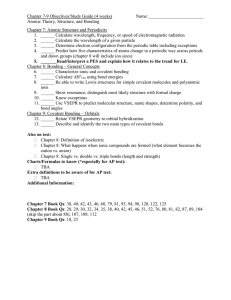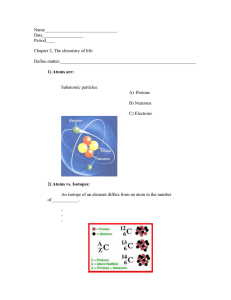
8.2
The Nature of
Covalent Bonding
>
The Octet Rule in Covalent Bonding
The Octet Rule in Covalent Bonding
What is the result of electron sharing in
covalent bonds?
Slide
1 of 50
© Copyright Pearson Prentice Hall
End Show
8.2
The Nature of
Covalent Bonding
>
The Octet Rule in Covalent Bonding
In covalent bonds, electron sharing
usually occurs so that atoms attain the
electron configurations of noble gases.
Slide
2 of 50
© Copyright Pearson Prentice Hall
End Show
8.2
The Nature of
Covalent Bonding
>
Single Covalent Bonds
Two atoms held together by sharing a pair of
electrons are joined by a single covalent bond.
Slide
3 of 50
© Copyright Pearson Prentice Hall
End Show
8.2
The Nature of
Covalent Bonding
>
Single Covalent Bonds
An electron dot structure such as H:H
represents the shared pair of electrons of
the covalent bond by two dots.
A structural formula represents the covalent
bonds by dashes and shows the
arrangement of covalently bonded atoms.
Slide
4 of 50
© Copyright Pearson Prentice Hall
End Show
8.2
The Nature of
Covalent Bonding
>
Single Covalent Bonds
The halogens form single covalent bonds in their
diatomic molecules. Fluorine is one example.
Slide
5 of 50
© Copyright Pearson Prentice Hall
End Show
8.2
The Nature of
Covalent Bonding
>
Single Covalent Bonds
A pair of valence electrons that is not shared
between atoms is called an unshared pair, also
known as a lone pair or a nonbonding pair.
Slide
6 of 50
© Copyright Pearson Prentice Hall
End Show
8.2
The Nature of
Covalent Bonding
>
Single Covalent Bonds
The hydrogen and oxygen atoms attain noblegas configurations by sharing electrons.
Slide
7 of 50
© Copyright Pearson Prentice Hall
End Show
8.2
The Nature of
Covalent Bonding
>
Single Covalent Bonds
The ammonia molecule has one unshared pair
of electrons.
Slide
8 of 50
© Copyright Pearson Prentice Hall
End Show
8.2
The Nature of
Covalent Bonding
>
Single Covalent Bonds
Methane has no unshared pairs of electrons.
Slide
9 of 50
© Copyright Pearson Prentice Hall
End Show
8.1
Section Assessment
Slide
10 of 50
© Copyright Pearson Prentice Hall
End Show
Section Assessment
Slide
11 of 50
© Copyright Pearson Prentice Hall
End Show
8.1
Section Assessment
Slide
12 of 50
© Copyright Pearson Prentice Hall
End Show
Practice Problems for Conceptual Problem 8.1
Section Assessment
Problem Solving 8.8
Solve Problem 8 with the
help of an interactive
guided tutorial.
Slide
13 of 50
© Copyright Pearson Prentice Hall
End Show
8.2
The Nature of
Covalent Bonding
>
Double and Triple Covalent Bonds
Double and Triple Covalent Bonds
How do atoms form double or triple
covalent bonds?
Slide
14 of 50
© Copyright Pearson Prentice Hall
End Show
8.2
The Nature of
Covalent Bonding
>
Double and Triple Covalent Bonds
Atoms form double or triple covalent
bonds if they can attain a noble gas
structure by sharing two pairs or three
pairs of electrons.
Slide
15 of 50
© Copyright Pearson Prentice Hall
End Show
8.2
The Nature of
Covalent Bonding
>
Double and Triple Covalent Bonds
A bond that involves two shared pairs of
electrons is a double covalent bond. (ex: O2
has a double covalent bond between the two
oxygen atoms)
A bond formed by sharing three pairs of
electrons is a triple covalent bond. (ex. N2 has
a triple covalent bond between the two nitrogen
atoms)
Slide
16 of 50
© Copyright Pearson Prentice Hall
End Show
8.2
The Nature of
Covalent Bonding
>
Double and Triple Covalent Bonds
O2 molecule: Each oxygen atom has two
unshared pair of electrons. N2 molecule: Each
nitrogen has one pair of unshared electrons
Lewis dot structure of O2 and N2
Slide
17 of 50
© Copyright Pearson Prentice Hall
End Show
8.2
The Nature of
Covalent Bonding
>
Double and Triple Covalent Bonds
Carbon dioxide gas is soluble in water and is
used to carbonate many beverages. A carbon
dioxide molecule has two carbon-oxygen double
bonds.
Slide
18 of 50
© Copyright Pearson Prentice Hall
End Show
8.2
The Nature of
Covalent Bonding
>
Double and Triple Covalent Bonds
Carbon dioxide is an example of a triatomic
molecule.
Slide
19 of 50
© Copyright Pearson Prentice Hall
End Show
8.2
The Nature of
Covalent Bonding
>
Coordinate Covalent Bonds
Coordinate Covalent Bonds
How are coordinate covalent bonds
different from other covalent bonds?
Slide
20 of 50
© Copyright Pearson Prentice Hall
End Show
8.2
The Nature of
Covalent Bonding
>
Coordinate Covalent Bonds
In a coordinate covalent bond, the
shared electron pair comes from one of
the bonding atoms.
Slide
21 of 50
© Copyright Pearson Prentice Hall
End Show
8.2
The Nature of
Covalent Bonding
>
Coordinate Covalent Bonds
A coordinate covalent bond is a covalent
bond in which one atom contributes both
bonding electrons.
In a structural formula, you can show
coordinate covalent bonds as arrows that
point from the atom donating the pair of
electrons to the atom receiving them.
Slide
22 of 50
© Copyright Pearson Prentice Hall
End Show
8.2
Section Assessment
Slide
23 of 50
© Copyright Pearson Prentice Hall
End Show
8.2
Section Assessment
Slide
24 of 50
© Copyright Pearson Prentice Hall
End Show
8.2
Section Assessment
Slide
25 of 50
© Copyright Pearson Prentice Hall
End Show
8.2
The Nature of
Covalent Bonding
>
Coordinate Covalent Bonds
A polyatomic ion, such as NH4+, is a tightly
bound group of atoms that has a positive or
negative charge and behaves as a unit. One of
its bonds is a coordinate covalent bond.
Most plants need nitrogen that is already
combined in a compound to grow.
Slide
26 of 50
© Copyright Pearson Prentice Hall
End Show
The Nature of
Covalent Bonding
>
Metallic
Bonding
(ch 7)
Bonding in:
NaCl ?
HCl ? H2O ?
Bonding in ionic
compounds containing
polyatomic ions:
Na2CO3 ?
BaSO4 ? NH4Cl ?
Ionic
Bonding
(ch 7)
Covalent
Bonding
(ch 8)
© Copyright Pearson Prentice Hall
Slide
27 of 50
End Show
8.2
The Nature of
Covalent Bonding
>
Bond Dissociation Energies
Bond Dissociation Energies
How is the strength of a covalent bond
related to its bond dissociation energy?
Slide
28 of 50
© Copyright Pearson Prentice Hall
End Show
8.2
The Nature of
Covalent Bonding
>
Bond Dissociation Energies
The energy required to break the bond between
two covalently bonded atoms is known as the
bond dissociation energy.
A large bond dissociation energy
corresponds to a strong covalent bond.
Slide
29 of 50
© Copyright Pearson Prentice Hall
End Show
Other Theories of Bonding?
The octet rule does not allow us to
understand bonding in ALL molecules.
Resonance is a concept used to explain
some of the compounds that do not
conform to the octet rule (Ex. Ozone O3)
Other theories? Molecular Orbital Theory
Slide
30 of 50
© Copyright Pearson Prentice Hall
End Show
8.2
The Nature of
Covalent Bonding
>
Resonance
Ozone in the upper
atmosphere blocks
harmful ultraviolet
radiation from the sun.
At lower elevations, it
contributes to smog.
Slide
31 of 50
© Copyright Pearson Prentice Hall
End Show
8.2
The Nature of
Covalent Bonding
>
Resonance
The actual bonding of oxygen atoms in
ozone is a hybrid, or mixture, of the
extremes represented by the resonance
forms.
Slide
32 of 50
© Copyright Pearson Prentice Hall
End Show
8.2
The Nature of
Covalent Bonding
>
Resonance
A resonance structure is a structure that
occurs when it is possible to draw two or more
valid electron dot structures that have the same
number of electron pairs for a molecule or ion.
Slide
33 of 50
© Copyright Pearson Prentice Hall
End Show
8.2
The Nature of
Covalent Bonding
>
Exceptions to the Octet Rule
Exceptions to the Octet Rule
What are some exceptions to the rule?
The octet rule cannot be satisfied in
molecules whose total number of
valence electrons is an odd number (ex.
NO2) There are also molecules in which
an atom has fewer (ex, BF3), or more (ex.
SF6; PCl5), than a complete octet of
Slide
valence electrons.
34 of 50
© Copyright Pearson Prentice Hall
End Show
8.2 Section Quiz.
Assess students’ understanding
of the concepts in Section 8.2.
Continue to:
-or-
Launch:
Section Quiz
Slide
35 of 50
© Copyright Pearson Prentice Hall
End Show
8.2 Section Quiz.
1. In covalent bonding, atoms attain the
configuration of noble gases by
a. losing electrons.
b. gaining electrons.
c. transferring electrons.
d. sharing electrons.
Slide
36 of 50
© Copyright Pearson Prentice Hall
End Show
8.2 Section Quiz
2. Electron dot diagrams are superior to
molecular formulas in that they
a. show which electrons are shared.
b. indicate the number of each kind of atom in
the molecule.
c. show the arrangement of atoms in the
molecule.
d. are easier to write or draw.
Slide
37 of 50
© Copyright Pearson Prentice Hall
End Show
8.2 Section Quiz
3. Which of the following molecules would
contain a bond formed when atoms share
three pairs of electrons?
a. Se2
b. As2
c. Br2
d. Te2
Slide
38 of 50
© Copyright Pearson Prentice Hall
End Show
8.3 Theory
VSEPR
VSEPR Theory
How does VSEPR theory help predict the shapes
of molecules?
Slide
39 of 50
© Copyright Pearson Prentice Hall
End Show
8.3 Theory
VSEPR
a. The hydrogens in a methane molecule
are at the four corners of a geometric
solid. All of the H—C—H angles are
109.5°, the tetrahedral angle. (See
Models)
Slide
40 of 50
© Copyright Pearson Prentice Hall
End Show
8.3 Theory
VSEPR
a. The valence-shell electron-pair repulsion
theory, or VSEPR theory, explains the
three-dimensional shape of methane.
Slide
41 of 50
© Copyright Pearson Prentice Hall
End Show
8.3 Theory
VSEPR
According to VSEPR theory, the repulsion
between electron pairs causes molecular
shapes to adjust so that the valenceelectron pairs stay as far apart as possible.
HCl, Cl2 are linear diatomic molecules
CO2 is linear triatomic
H2O has a bent shape, NH3 has a pyramidal shape
and CH4 has a tetrahedral shape.
Activity: Molecular Models Lab
Slide
42 of 50
© Copyright Pearson Prentice Hall
End Show
8.3 Theory
VSEPR
a. NH3 has a pyramidal shape and the
measured H—N—H bond angle is about
107.
b. (See Models)
Slide
43 of 50
© Copyright Pearson Prentice Hall
End Show
8.3 Theory
VSEPR
a. H2O has a bent shape and the measured
bond angle in water is about 105°. (See
Models)
Slide
44 of 50
© Copyright Pearson Prentice Hall
End Show


